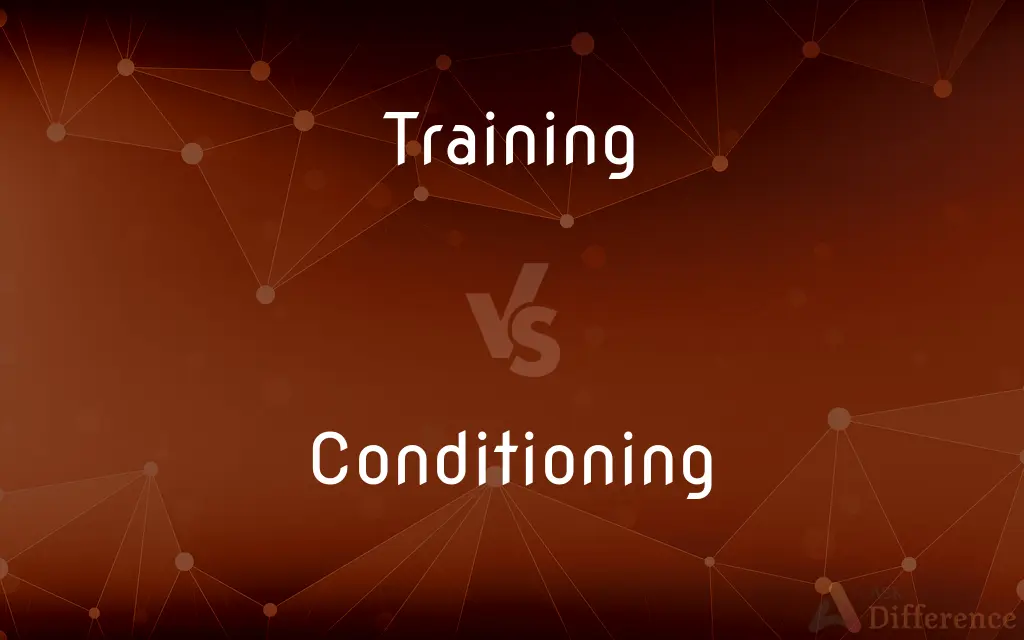Training vs. Conditioning — What's the Difference?
By Maham Liaqat & Urooj Arif — Updated on March 12, 2024
Training involves systematic practice to improve skill, strength, or knowledge, while conditioning develops specific responses to stimuli, often enhancing physical fitness or behavior.

Difference Between Training and Conditioning
Table of Contents
ADVERTISEMENT
Key Differences
Training is a broad term that encompasses a range of activities aimed at enhancing skill, strength, endurance, or knowledge to achieve a specific goal or improve performance in a particular area. It is often structured and can be related to physical fitness, education, or professional development. Whereas conditioning is more narrowly focused on developing a specific response or adapting to a particular stimulus.
Training focuses on learning new skills or improving existing ones, incorporating both theory and practical application. In the context of physical fitness, conditioning aims to improve overall physical readiness, focusing on cardiovascular fitness, strength, and endurance. It involves repetitive exercises or routines that condition the body or mind to perform optimally under certain conditions.
Training often includes a mix of theoretical learning and practical application, aiming to develop a comprehensive skill set or knowledge base. For instance, professional training might combine classroom learning with on-the-job practice. On the other hand, conditioning typically involves repeated physical exercises or drills that trigger physiological adaptations, enhancing the body's efficiency and performance in response to those specific activities.
While training can be designed for a wide range of purposes, from educational development to skill acquisition in sports, conditioning is usually aimed at physical preparation. Conditioning routines are designed to increase stamina, strength, and flexibility, preparing individuals for physical challenges or enhancing their ability to perform specific tasks repeatedly.
An athlete, for example, might undergo training to improve technique in a sport, learning new strategies or refining skills, such as shooting in basketball or tackling in football. Meanwhile, their conditioning regimen focuses on physical aspects, such as increasing lung capacity, muscle strength, and endurance, ensuring they can maintain high performance throughout a game.
ADVERTISEMENT
Despite their differences, training and conditioning often overlap, especially in sports and physical fitness contexts, where the development of skill and physical readiness are both essential for peak performance. Effective training programs typically incorporate elements of conditioning to ensure that individuals are not only skilled but also physically prepared to apply those skills effectively.
Comparison Chart
Focus
Skill, knowledge, or strength improvement
Developing specific responses or physical fitness
Purpose
Enhance performance, learn new skills
Enhance physical readiness, adapt to stimuli
Methods
Theoretical learning, practical application
Repetitive exercises, drills
Applications
Education, sports, professional development
Physical fitness, behavior modification
Outcome
Improved performance, skill acquisition
Increased stamina, strength, adaptation to stimuli
Compare with Definitions
Training
Educational Development.
Corporate training programs aim to enhance employee skills and knowledge.
Conditioning
Specific Physiological Changes.
Strength conditioning focuses on increasing muscle power and endurance.
Training
Structured Learning.
Pilot training includes both simulator sessions and actual flying hours.
Conditioning
Behavioral Response Training.
Classical conditioning can be used to modify pet behavior.
Training
Skill Improvement.
Soccer training focuses on passing, dribbling, and shooting techniques.
Conditioning
Preparation for Specific Activities.
Conditioning exercises for dancers improve flexibility and aerobic capacity.
Training
Physical and Mental Preparation.
Emergency response training prepares individuals for crisis situations.
Conditioning
Physical Fitness Enhancement.
Conditioning routines for boxers include high-intensity interval training for endurance.
Training
Goal-Oriented.
Training for a marathon involves a mix of running, strength training, and nutrition planning.
Conditioning
Stimulus Adaptation.
High-altitude conditioning prepares climbers for reduced oxygen levels.
Training
Training is teaching, or developing in oneself or others, any skills and knowledge or fitness that relate to specific useful competencies. Training has specific goals of improving one's capability, capacity, productivity and performance.
Conditioning
A learning process by which a subject develops a consistent response to a previously unrelated stimulus, either by reward or punishment (as in operant conditioning) or by association of the stimulus with another stimulus that already elicits the response (as in classical conditioning).
Training
The process or routine of one who trains.
Conditioning
The process of training that results in physical fitness.
Training
The state of being trained.
Conditioning
The state of physical fitness that results from such training.
Training
The act of one who trains; the act or process of exercising, disciplining, etc.; education.
Conditioning
The process of modifying a person or animal's behaviour.
Training
Present participle of train
Conditioning
Any preparation or training, especially athletic training of the body.
Training
Action of the verb to train. en
Conditioning
The storage of a material specimen under specified temperature, humidity for a specified time prior to testing.
Training
The activity of imparting and acquiring skills.
Conditioning
Present participle of condition
Training
The result of good social upbringing.
Conditioning
A learning process in which an organism's behavior becomes dependent on the occurrence of a stimulus in its environment. See conditioned response.
Training
(computing) The process by which two modems determine which protocol and speed to use; handshaking.
Conditioning
A learning process in which an organism's behavior becomes dependent on the occurrence of a stimulus in its environment
Training
(voice recognition) The recording of multiple samples of a user's voice to aid pattern recognition.
Training
Activity leading to skilled behavior
Training
The result of good upbringing (especially knowledge of correct social behavior);
A woman of breeding and refinement
Common Curiosities
What is the main difference between training and conditioning?
Training is aimed at improving skills, knowledge, or strength, while conditioning focuses on developing specific responses or physical fitness.
How does training benefit professionals outside of sports?
Professional training enhances skills and knowledge, contributing to career development and improving job performance.
Can conditioning affect behavior?
Yes, conditioning can be used to modify behavior through repeated association of stimuli and responses, as seen in classical and operant conditioning.
How do training and conditioning overlap in sports?
In sports, training develops technique and strategy, while conditioning builds the physical fitness required to perform those techniques effectively.
Can training be self-directed?
Yes, individuals can undertake self-directed training, especially with the availability of online resources, though guidance enhances effectiveness.
How does professional development incorporate training?
Professional development often incorporates training through workshops, courses, and seminars to enhance employees' skill sets.
Is conditioning only physical?
While often associated with physical fitness, conditioning can also refer to behavioral modifications through psychological techniques.
Can anyone undergo conditioning?
Yes, conditioning routines can be adapted for individuals at different fitness levels or with specific goals in mind.
Why is training important for skill development?
Training provides structured learning and practice opportunities, essential for acquiring new skills or improving existing ones.
How does conditioning improve performance?
Conditioning enhances physical and sometimes mental readiness, increasing stamina, strength, and adaptability for better performance.
What role does conditioning play in behavioral change?
Conditioning plays a crucial role in behavioral change by establishing or altering the association between stimuli and responses.
What makes conditioning effective in physical fitness?
Repetition and gradual increase in intensity make conditioning effective, leading to physiological adaptations and improved fitness.
Can training and conditioning be harmful if done incorrectly?
Yes, improper techniques or excessive intensity without adequate rest can lead to injuries or counterproductive outcomes.
How should one choose between training and conditioning?
The choice depends on goals: training for skill and knowledge improvement, and conditioning for physical fitness or behavioral adaptation.
What is an example of conditioning in everyday life?
An example of conditioning in everyday life is developing a habit of exercising at the same time daily, leading to automatic behavior.
Share Your Discovery

Previous Comparison
Beaver vs. Groundhog
Next Comparison
Revise vs. RephraseAuthor Spotlight
Written by
Maham LiaqatCo-written by
Urooj ArifUrooj is a skilled content writer at Ask Difference, known for her exceptional ability to simplify complex topics into engaging and informative content. With a passion for research and a flair for clear, concise writing, she consistently delivers articles that resonate with our diverse audience.
















































